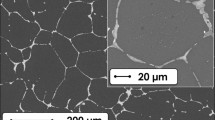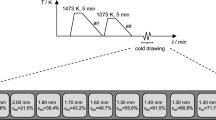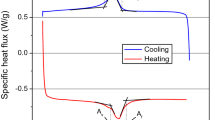Abstract
The study deals with the calorific response of a granular system made of Ni-Ti shape-memory-alloy (SMA) cylinders. SMAs belong to the family of active materials. Depending on their operating temperature, they feature unusual thermomechanical properties for metals: super-elasticity, one-way and two-way memory effects, as well as strong damping capacities. These properties take their origin from a solid-solid phase transformation accompanied by production or absorption of latent heat, which opens perspectives for the development of new heating/cooling systems. A “porous” material was built by placing SMA wires in parallel. It was subjected to confined compression with a uniaxial testing machine. Thermal measurements were performed by infrared thermography. Production and absorption of latent heat were observed in the contact zones between cylinders. Results enable us to envisage the circulation of a fluid through the SMA granular material for heat transfer.
Access provided by Autonomous University of Puebla. Download conference paper PDF
Similar content being viewed by others
Keywords
Introduction
Shape-memory alloys (SMAs) belong to the family of smart and active materials as they are temperature- and mechanical-responsive. Depending on the temperature, they feature unusual mechanical properties for metals: super-elasticity, one-way and two-way memory effects, as well as some strong damping capacities. These macroscopic properties have their origin in a diffusionless solid-solid phase transformation triggered by stress and temperature. The austenite-to-martensite phase transition in SMAs is accompanied by large reversible strains (several per-cents) as well as a production of latent heat. Since the 1990s, scientific studies on these materials have been very numerous. After an intense academic research phase, application development is now in full swing. For example, the review by Jani et al. [1] cites more than 400 articles and 100 patents in four major fields of application: automotive, aerospace, robotics and biomedical. In parallel, thousands of patents involving SMA components have been proposed. SMAs are used as mechanical actuators or thermal sensors in a multitude of devices. Recently, applications to cooling and/or heating systems have been developed: see for instance [2,3,4]. Some studies also concern the analysis of the elastocaloric effect of superelastic SMAs for potential use in heating and cooling devices: see for instance [5,6,7,8]. The aim of the present study is to build an elastocaloric “granular” material by placing superelastic SMA cylinders in parallel (forming thus a so-called Schneebeli material [9]). Each cylinder corresponds thus to a particle of a two-dimensional (2D) discrete medium. This configuration allows us to envisage the circulation of a fluid through the “porous” material thus created, for heat transfer from the superelastic SMA wires to the fluid.
Granular materials are generally composed of grains with various sizes and shapes of particles, as well as different constitutive materials: sands, soils, rocks (civil engineering), cereals, sugar and rice (agro-food processing industry), raw particles (pharmaceutical industry). They exhibit mechanical behaviors that differ from common solids, liquids, and gases [10] because the mechanical response is governed by the contact forces between particles. Under macroscopic mechanical loading, a granular material is characterized by a heterogeneous network of interparticle forces [11]. Numerous numerical investigations have been presented in the literature to analyze the influence of parameters such as particle size and shape [12,13,14], friction [15], surface energy [16] and base materials [17]. Experimental approaches are also available, involving in particular full-field measurement techniques. To the best knowledge of the authors, granular materials made in SMA have never been studied in the literature. The objective of the present study is to perform experimental and numerical validation of a SMA Schneebeli material to be used for heat transfer to a fluid.
The paper is divided in four parts as follows. The first section presents the experimental setup used to analyze the thermomechanical response of a SMA Schneebeli material under confined compression. The second section is devoted to preliminary 2D finite element (FE) simulations to visualize the distribution of austenite and martensite phases inside the SMA cylinders under load. The third section presents the experimental results in terms of temperature change in the SMA cylinders. The last section proposes a demonstrator employing air as a fluid circulating in the elastocaloric material system.
Experimental Setup
Figure 14.1 presents the experimental setup for the thermomechanical analysis of a SMA Schneebeli material under confined compression. A long bar in nickel-titanium (Ni-Ti) SMA, 2 m in length and 3.81 mm in mm, was supplied by Fort Wayne Metals. This alloy featured an austenite-finish (Af) temperature around 14 °C. At ambient temperature, the austenite-to-martensite stress plateau upon loading in tension was at around 480 MPa. The stress plateau for the reverse transformation (martensite-to-austenite) upon unloading was at around 140 MPa. Small cylinders, 25 mm in length, were cut and slightly polished to obtain smooth surfaces. Once placed in the rectangular frame, black paint was applied on the ends of the cylinders to maximize the thermal emissivity. Close environment was covered by thick black fabric to limit parasitic reflection in the infrared range.
The mechanical loading was applied with a Schenck uniaxial machine equipped with a ±250 kN load cell. The test consisted of a displacement-controlled compression phase applied with a rate of −1 mm s−1 until a maximum force of Fmax = −150 kN, followed by an immediate unloading phase (in about 40 ms) after reaching the maximum compression force. The maximum force of −150 kN was defined from preliminary FE simulations (see the next section). Before starting the test, several load-unload cycles were applied to pack the granular system, followed by a waiting time of 30 min in order to start the loading from a thermal equilibrium state.
Tests were performed as ambient temperature Tamb = 24.5 °C, so the SMA cylinders were purely austenite in the stress-free state (Tamb > Af). A Cedip Jade III-MWIR infrared camera was employed to capture the temperature fields. The spatial resolution of the thermal measurement was equal to 88.6 μm. Recording frequency was set to 147 Hz, leading to a temporal resolution of 6.80 ms. Temperature changes during a mechanical test were obtained by subtracting the initial temperature field captured before starting the test.
Finite Element Simulations
FE simulations were performed to model the force transfer in a periodic granular system made in superelastic SMA. Ansys package was employed for this purpose. The Auricchio’s SMA model is implemented in the software [18]. A 2D calculation with a hypothesis of plane stresses was considered, which can be accepted for comparisons with experimental results. Indeed, thermal measurements by IR thermography were done on free surfaces, i.e. surfaces in a plane-stress state. Element PLANE182 of Ansys was used to mesh the cylinders. Periodic organization of the cylinder network was assumed in the simulations.
Figure 14.2a shows the field of martensite volume fraction x in the granular medium under a vertical compression force of −150 kN. Pure austenite and pure martensite correspond to x = 0 and x = 1 respectively, whereas x ∈ ]0; 1[ corresponds to a mix of the two phases. Figure 14.2a shows that martensite is present only in the contact zones, which is logical because these zones are subjected to higher stresses. It can be noted also that martensite is more present in the bottom and upper rows of cylinders. This result can be justified by the fact that these cylinders have fewer contacts than the others, so they are potentially subjected to higher contact forces. Figure 14.2b shows the field of Von Mises stress in the austenitic zones. It appears that the cylinders in contact with the two vertical walls feature lowest Von Mises stresses. This is why less martensite is produced in these boundary cylinders.
Martensite volume fraction x can be considered as proportional to the latent heat produced. In the case of an adiabatic transformation, the same property is true for the temperature change θ, i.e. x should be in theory proportional to θ. Compression force of −150 kN was considered as relevant to exhibit detectable heterogeneous temperature changes in the granular system. Next section analyzes the experimental temperature changes obtained by IR thermography.
Experimental Results
Figure 14.3a shows the field of temperature change θ for the maximum compression force Fmax = −150 kN. It can be seen that the cylinder network is not perfectly periodic. As a consequence, the field of temperature change due to contact forces is not periodic either. Strong temperature increases are visible in certain cylinders. Temperature rises of more than 3 °C are detected in the contact zones between cylinders. They can be attributed to an austenite-to-martensite transformation. They can be also attributed to thermoelastic couplings as well as mechanical dissipation due to friction. Lowest temperature changes are on the right side of the granular system. This can be explained by the fact that the cylinder at the top right was not subjected to mechanical loading. Indeed, no temperature change is detected in this cylinder.
Figure 14.3b shows the field of temperature change θ at the end of the unloading phase. Strong temperature decreases are detected at the contacts between cylinders: θ reached around −3 °C in certain zones. These temperature drops can be attributed to the reverse phase transformation, i.e. to the martensite-to-austenite transformation. It can be noted that the temperature gradients are more concentrated for the unloading phase than for during the loading phase. This can be explained by the rapid unloading phase, leading to better adiabaticity than for the loading phase. Identification of strong temperature drops during the unloading phase could be advantageously used to reveal contact force networks in such a granular medium.
Differences between the (experimental) field of temperature change θ in Fig. 14.3a and the (simulated) field of martensite volume fraction x in Fig. 14.2a can be explained by several reasons: (1) experimental loading is not fast enough to achieve adiabaticity; (2) thermoelastic coupling is not taken into account in the simulation; (3) the placement of the cylinders in the experiment is not perfectly periodic. This later reason is probably the most important. Indeed, the force network is strongly impacted by the actual locations of the cylinders. Any slight fluctuations from the perfectly periodic configuration lead to major changes in the interparticle force network.
Demonstrator of Elastocaloric Device
A demonstrator was designed to show that an elastocaloric granular system made of SMA cylinders can be used for heating or cooling a fluid: see Fig. 14.4. Air was chosen for the first validation tests. The mechanical loading applied to the granular system was cyclic: force-controlled at a frequency of 0.17 Hz, minimum and maximum vertical force of −18 kN and −180 kN respectively. The rotation speed of the fan was set to 3200 rpm. Air thus circulated between the cylinders during the cyclic confined compression loading. A type-K thermocouple was used to measure the output temperature. A cyclic oscillation of the air temperature at the same frequency of the mechanical loading was evidenced. The amplitude of the oscillation was of nearly 0.2 °C. A maximum temperature rise of 0.5 °C was measured at the beginning of the loading. These temperature levels are small because of the fluid used. However, the demonstrator opens perspectives for the design of efficient elastocaloric granular systems made of SMA wires by using a real heat transfer fluid and another mechanical solicitation mode.
Conclusion
The calorific response of a granular system made of superelastic Ni-Ti SMA wires subjected to confined compression was analyzed by IR thermography. Strong heat production was observed at some contacts, revealing localized austenite-to-martensite transformation due to the contact forces. Results allow us to envisage the circulation of a fluid through the SMA granular system for heat transfer. A first demonstrator was developed, opening perspectives for the design of new elastocaloric systems made of SMA wires.
References
J.M. Jani, M. Leary, A. Subic, M.A. Gibson, A review of shape memory alloy research, applications and opportunities. Mater. Des. 56, 1078–1113 (2014)
H. Ossmer, C. Chluba, S. Kauffmann-Weiss, E. Quandt, M. Kohl, TiNi-based films for elastocaloric microcooling-Fatigue life and device performance. APL Mater. 4, 064102 (2016)
F. Bruederlin, H. Ossmer, F. Wendler, S. Miyazaki, M. Kohl, SMA foil-based elastocaloric cooling: from material behavior to device engineering. J. Phys. D Appl. Phys. 50, 424003 (2017)
D. Luo, Y.S. Feng, P. Verma, Modeling and analysis of an integrated solid state elastocaloric heat pumping system. Energy 130, 500–514 (2017)
J. Tusek, K. Engelbrecht, L.P. Mikkelsen, N. Pryds, Elastocaloric effect of Ni-Ti wire for application in a cooling device. J. Appl. Phys. 117, 124901 (2015)
K. Engelbrecht, J. Tusek, S. Sanna, D. Eriksen, O.V. Mishin, C.R.H. Bahl, N. Pryds, Effects of surface finish and mechanical training on Ni-Ti sheets for elastocaloric cooling. APL Mater. 4, 064110 (2016)
J. Tusek, A. Zerovnik, M. Cebron, M. Brojan, B. Zuzek, K. Engelbrecht, A. Cadelli, Elastocaloric effect vs fatigue life: exploring the durability limits of Ni-Ti plates under pre-strain conditions for elastocaloric cooling. Acta Mater. 150, 295–307 (2018)
M. Zhou, Y.S. Li, C. Zhang, L.F. Li, Elastocaloric effect and mechanical behavior for NiTi shape memory alloys. Chin. Phys. B 27, 106501 (2018)
G. Schneebeli, Une analogie mécanique pour les terres sans cohésion. C. R. Hebd. Acad. Sci. 243, 125–126 (1956)
H.M. Jaeger, S.R. Nagel, Granular solids, liquids, and gases. Rev. Mod. Phys. 68, 1259–1272 (1996)
S. Ostojic, E. Somfai, B. Nienhuis, Scale invariance and universality of force networks in static granular matter. Nature 439, 828–830 (2006)
D.H. Nguyen, E. Azéma, F. Radjai, P. Sornay, Effect of size polydispersity versus particle shape in dense granular media. Phys. Rev. E 90, 012202 (2014)
A.A. Peña, R. García-Rojo, H.J. Herrmann, Influence of particle shape on sheared dense granular media. Granul. Matter 9, 279–291 (2007)
C. Nouguier-Lehon, B. Cambou, E. Vincens, Influence of particle shape and angularity on the behaviour of granular materials: a numerical analysis. Int. J. Numer. Anal. Methods Geomech. 27, 1207–1226 (2003)
S.G. Bardenhagen, J.U. Brackbill, D. Sulsky, Numerical study of stress distribution in sheared granular material in two dimensions. Phys. Rev. E 62, 3882–3890 (2000)
I. Preechawuttipong, R. Peyroux, F. Radjai, W. Rangsri, Static states of cohesive granular media. J. Mech. Sci. Technol. 21, 1957–1963 (2007)
P. Jongchansitto, I. Preechawuttipong, X. Balandraud, M. Grédiac, Numerical investigation of the influence of particle size and particle number ratios on texture and force transmission in binary granular composites. Powder Technol. 308, 324–333 (2017)
F. Auricchio, A robust integration-algorithm for a finite-strain shape-memory-alloy. Int. J. Plast. 17, 971–990 (2001)
Acknowledgements
The authors gratefully acknowledge the Ministère de l’Europe et des Affaires Etrangères (MEAE) and the Ministère de l’Enseignement supérieur, de la Recherche et de l’Innovation (MESRI) in France, as well as the Office of the Higher Education Commission (OHEC) of the Ministry of Education in Thailand. The authors also gratefully thank the French Embassy in Thailand and Campus France for their support during this research (PHC SIAM 2018, Project 40710SE). The authors would also like to acknowledge the financial support through the Research Grant for New Scholar (MRG6080251) from the Thailand Research Fund (TRF) and Thailand’s Office of the Higher Education Commission (OHEC). Finally, the authors gratefully thank Mr. Axel Cariat, Sigma-Clermont Engineering School, for the preliminary finite element models, as well as Mr. Alexis Gravier and Mr. Clément Weigel, Sigma-Clermont Engineering School, for the manufacturing of the mechanical devices.
Author information
Authors and Affiliations
Corresponding author
Editor information
Editors and Affiliations
Rights and permissions
Copyright information
© 2020 Society for Experimental Mechanics, Inc.
About this paper
Cite this paper
Yachai, T., Boufayed, R., Jongchansitto, P., Preechawuttipong, I., Balandraud, X. (2020). Calorific Analysis of a Granular System Made in Shape Memory Alloy. In: Baldi, A., Kramer, S., Pierron, F., Considine, J., Bossuyt, S., Hoefnagels, J. (eds) Residual Stress, Thermomechanics & Infrared Imaging and Inverse Problems, Volume 6. Conference Proceedings of the Society for Experimental Mechanics Series. Springer, Cham. https://doi.org/10.1007/978-3-030-30098-2_14
Download citation
DOI: https://doi.org/10.1007/978-3-030-30098-2_14
Published:
Publisher Name: Springer, Cham
Print ISBN: 978-3-030-30097-5
Online ISBN: 978-3-030-30098-2
eBook Packages: EngineeringEngineering (R0)








